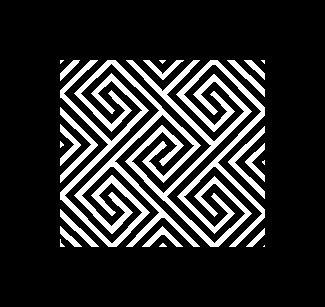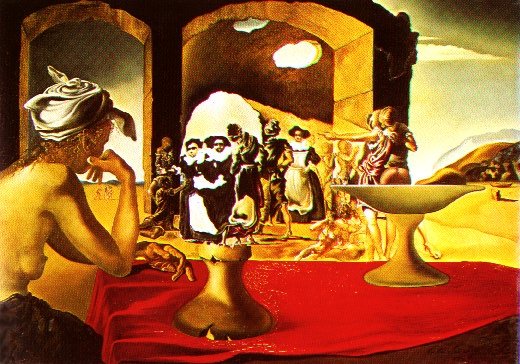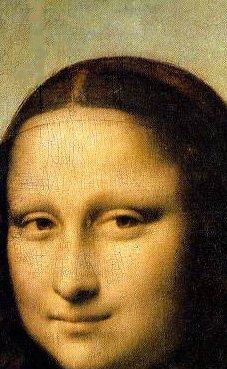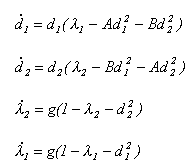
AMBIGUITY AND ART Igor Yevin Mechanical Engineering Research Institute, Moscow, Russia Kv.40 dom 45, Moscowskoe shosse, Dolgoprudny, 141700 Russia Phone: (095) 576-04-72, e-mail: yevin@com2com.ru
In perception psychology, multistabile perception of ambiguous figures is often considered as a marginal curiosity. Nevertheless, this phenomenon is one of the most investigated psychological phenomena, because it has attracted perceptual scientists since the first description of ambiguity, given by Necker in 1832. Actually, ambiguous patterns are not freak phenomena. Some authors argued, that every pattern, in a way, is ambiguous multistable pattern, but in everyday life, using additional information, we usually resolve or avoid ambiguity [8]. Nikos Legothetis recently shown that resolution of ambiguity is an assential part of consciousness job [1]. The objective of this paper is to show that the mathematical models of the perception of ambiguous patterns can be regarded as the basic models of artistic perception. Ambiguous patterns are examples of two-state, bimodal systems in psychology. When we perceive ambiguous figure, like the fourth picture in the row on Figure 1, the perception switches between two interpretations, namely "man's face" or "kneeling girl" because it is impossible for the brain to recognize both interpretations simultaneusly. Various authors pointed out that ambiguous figures possess non-linear properties, and that multistabile perception could be modeled by catastrophe theory methods [2,3,4].

Figure 1. Ambiguous patterns are two-state systems. Their perception can be modeled by using elementary catastrophe "cusp" [1]. The switch between two interpretation could be described by elementary catastrophe "cusp" x3 - bx - a = 0, where a and b are control parameters and x is the state variable. The first parameter a quantitatively describes the change in bias in the drawing. The second parameter b describes how much the amount of detailes is presented in the ambiguous figure. The state variable x is presented as a scale from +10 ("looks a lot like a man's face") to - 10 ("looks a lot like kneeling girl"). For this model we could formally represent potential function V = - 1/4x4 + bx2 + ax which depicted on Figure 1, and consider catastrophic jump from one image to another as non-equilibrium phase transition. It is worth to note, that unlike to physical sciences, where potential function usually deduces from fundamental laws or standart theories, in mathematical models in psychology and others "inexact sciences" potential function is hypothesized and really is considered not as potential energetic function, but funtional, which should be minimized. Haken offered another approach to the description of pattern recognition [5]. Each pattern is described in this model as a vector in the space of quantitative parameters. There is a procedure for selecting non-correlated parameters, which enable to reduce an information volume. The most informative parameters are the order parameters (all they peculiarities occur near critical points, as in the case of order parameters near phase transition [5]). Pattern recognition procedure is the following. First, pattern-prototypes are stored in the computer memory. Then, the pattern that should be recognized is inputted. The recognition dynamics is built in such a way, that its vector evolves in a parameter space to the most similar pattern stored in the computer memory. The prototype patterns are encoded by vectors Vi (i=1,M). It is assumed that all these vectors are linearly independent. The components of every vector encode the features of the patterns.

Figure 2. Patterns representation in parameter space.
A pattern to be recognized is encoded by a vector Q(0) and is inputted in a computer memory at t=0. A dynamic of pattern recognition is constructed so that Vi (i=1,M), that is the initial vector Q(t), is pulled into one of prototype patterns Vk with which it mostly coincides. Recognized pattern is presented as the linear combination of prototype patterns
where di(t) is the order parameter, characterizing the degree to which a pattern is recognized, and x (t) is a residual, uncorrelated with Vi.The dynamic of pattern recognition is described as a gradient process in networks with only M neurons according to
This system has only the attractors of the type (0, 0,..., dk¹0, 0,...,.0). It can be shown that they must be either saddle points or nodes, but not limit circles (oscillations). The recognition of ambiguous patterns has very profound and various analogies with numerous artistic phenomena.

Figure 3. Image ambiguity: "young girl" Ė "old lady". In that ambiguous figure, we perceive for few second the young woman, then the old woman, then again the young woman, etc. Ditzinger and Haken offered the synergetic model of the perception of ambiguous patterns, describing dynamical features of such perception. It was based on the model of pattern recognition described above, and the model of the saturation of attention. The recognition of ambiguous patterns is reduced to inputting only two patterns-prototypes (e.g., "young girl" and "old lady") into computer memory with the order parameters d1 and d2. In this case the dynamics of pattern recognition is described in the following way:
where the overdot means d/dt, l 1 and l 2 are time dependent attention parameters, and A, B, and g are constants. The last two equations describe the saturation of attention in the perception of prototype patterns. As analysis shows, the oscillation of perception occurs when the appropriate relations between constants are satisfied [5].Let us first consider visual ambiguity in art. An example of such ambiguity is The Slave Market with Disappearing Bust of Voltaire by Salvador Dali.

Figure 4. Ambiguity of Voltaire bust in Salvador Dali's painting The Slave Market with Disappearing Bust of Voltaire The most famous example of ambiguity in painting is, of course, Mona Lisa by Leonardo. In The Story of Art Ernest Gombrich said: "Even in photographs of the picture we experience this strange effect, but in front of the original in the Paris Louvre it is almost uncanny. Sometimes she seems to mock at us, and then again we seem to catch something like sadness in her smile." "This is Leonardo's famous invention the Italians call "sfumato" - the blurred outline and mellowed colors that allow one form to merge with another and always leave something to our imagination. If we now turn to the "Mona Lisa", we may understand something of its mysterious effect. We see that Leonardo has used the means of his "sfumato" with the utmost deliberation. Everyone who has ever tried to draw or scribble a face knows that what we call its expression rests mainly in two features: the corners of the mouth, and the corners of the eyes. Now it is precisely these parts which Leonardo has left deliberately indistinct, but letting them merge into a soft shadow. That is why we are never quite certain in which mood Mona Lisa is really looking at us. Her expression always seems just elude us" [6, p.228]. Recognition of facial expression of emotion is one of the first communicative abilities in human life, that occurs much earlier in childhood than for instance the faculty of speech. Facial expression of basic emotions (joy, fear, etc.) form structure stable patterns and H.Haken with co-workers carried out experiments on computer recognition of some facial expressions irrespective of individual person. In these experiments the success rate was about 80 percent. The ambiguity of Mona Lisa's smile one can compare with ambiguous images like "young girl - old lady". The oscillation in the perception of that painting can be described by Ditzinger-Haken's model.

Figure 5. Ambiguity of Mona Lisaís smile. We see that brain resolves a visual ambiguity by means of oscillation. A semantic ambiguity (the ambiguity of meaning) is a result of ambiguous words or whole sentence [7]. Semantic ambiguity, wide spread in comic situations, also resolves by oscillations (like visual ambiguity). Let us consider semantic ambiguity occurring in double-meaning comic situations. Example of such ambiguity is the following note: DOG FOR SALE. EATS ANYTHING. LOVES CHILDREN. In ordinary speech, and especially in scientific communication, in general we try to avoid ambiguity; by contrast, in humor, one of the aims is to create ambiguous situations to provoke laughing. Here is D.D.Minayev's epigram: I can agree with you: The British poet was lame The rhymes of yours are also lame." The method used in this epigram is connected with a comparison based on different distant meanings (Byron was the lame, and a vain poet was also a lame, but in his rhymes). The situation described in this epigram is common to a lot of semantically ambiguous comic situations, which contain two states. One state we should call a state with high social status. This position is honorable and sometimes brings profit. The second state we should call a state with low social status. Everybody avoids occupying it. In the aforesaid example, the state with the high social status ("a good poet") we connect with words "a new Byron". Another poet is trying to get this state. But the author of the epigram unexpectedly transfers a poet to the second state with a low social status. This state we connect with the words "the rhymes of yours are also lame". Such an unexpected leap is achieved by using the same word ("lame") for totally different states. So, a feeling of comic is very often connected with sudden transition from a state of high social status to a state of low social status, or the other way round. Is it a single transition? Does it happens only once? Of course not. It is a multistabile perception of meaning. The rhythmical, repeating nature of laughter (ha-ha-ha, etc.) shows that such transitions are repeated. Evidently, a laughing person mentally oscillates every time from the state of high social status to the state of low social status and vice versa, by comparing them. As a result, the rhythmical laughter is generated by the nervous system. The origin of the oscillatory character of laughter should be connected with the fundamental property of the distributed neuron set, i.e. as the oscillation occurring in the perception of ambiguous patterns. According to Ditzinger-Haken's model of recognizing of ambiguous patterns, stable limit cycles can be formed in systems of usual nonlinear differential equations for those variables, which describe the visual perception (e.g. attention). Evidently, this is the common characteristic of distributing neuron sets. That's why it is manifested not only in evolutionary low stages (the ancient visual-morphologic structure of nervous and psychological activity of a human being), but also in its latest stages as well (in the semantic-analytical structures of the left cerebral hemisphere). Comic situations are very often connected with with polysemantic, i.e. semantically ambiguous, situations. In the above examples of comic situations words were used with a double meaning, so each of that situations has a double interpretation. Another situation of perception of ambiguous patterns occurs in a parody of a famous person by some actor. On one hand, we can recognize the manners, gestures, style and voice of that famous person. On the other hand, we see quite a different person. The same method is used in literary and poetic parodies. Every time, we are dealing with a bimodal, double-meaning situation. As a result, we have the oscillation of perception, and laughter is one of the external manifestations of this oscillation. One can assume that in ambiguous comic situations oscillations occur between two semantic images. The phenomena of synchronization are typical for a self-organizing process in an active medium (and the nerve substance is an active medium). From that, we can conclude that the period of oscillation between semantic patterns coincides with the period of outward macroscopic oscillations, manifested as laughter with the duration of about 0.1 sec. This value is much smaller than the oscillation period, which occurs when recognizing ambiguous figures (1-5 sec.). Why does laughter occurs in the perception of double-meaning situations, and not in the visual perception of ambiguous patterns? We can explain this by essentially different periods of the corresponding oscillations. In the visual perception this period is approximately equal to t=10 sec., and in the perception of the ambiguity of meaning this period is about t=0.1 sec. t=0.1 sec. That difference could be explained by the fact that a much smaller mass of nerve substance is involved in creating semantic patterns, compared with constructing visual patterns. This is because visual information is processed in the massive and ancient visual cortex, and semantic patterns are interpreted in compact Broke-Vernike zone in the left brain hemisphere. Anecdotes, jokes and sketches deliberately are created as short as possible (laconic), in order to reduce the time needed for the saturation of attention in the process of recognition. We have considered visual ambiguity in painting (see also [8,9]) and semantic ambiguity in jokes, anecdotes and puns. Let us consider mixed (visual and semantic) ambiguity, taking an example from acting. Like any human being, an actor has in his everyday life some set of rather stable physiological and psychological personal properties: sex, appearance, timbre of voice, gait, temper, and so on. The acting involves itís ability to create a second phase, a "role" phase, different from the original physiological and psychological nature of the actor. In other words, a bimodal "actor-role" state created may be compared with ambiguous patterns, for instance, the pattern where we see in turn "young girl" or "old lady". One may say that in this case young girl will "play the role" of old lady and vice versa. In acting, one can observe the existence of two polar types of actors: 1. An actor as a bright, brilliant individuality, eccentric person with the original appearance, and so on (Alain Delon, Arnold Schwarzenegger) (Figure 6b). It is rather easy to make a parody of such actors; 2. An actor with prominent outstanding abilities for transformation and reincarnation (Laurence Olivier, Alec Guiness)(Figure 6c). In that case, it is very difficult to make a parody.

Figure 6. Ambiguity of acting. In the case of acting the prototypes are, for instance, "Laurence Olivier" (the image of actor) and "Othello" (the image of character). Therefore, according to the common law of perception of ambiguous patterns, the oscillation of our attention takes place, and we see in turn either an actor or his role. One may suppose, that bimodality is connected with the notion of "play" ("child play", "actor play", "to play the piano"). Without ambiguity of natural languages, the existence of poetry is impossible. According to A.N.Kolmogorov, entropy of language H contains two terms: meaning capacity h1 - capability to transmit some meaning information in a text of appropriate length, and flexibility of language h2 - a possibility to transmit the same meaning by different means [10]. Namely h2 is a source of poetic information, and the ambiguity of language is one of the causes of itís flexibility. Languages of science usually have h2 =0, they exclude ambiguity, and cannot be used as a material for poetry. Rhythm, rhymes, lexical and stylistic norms of poetry will put some restrictions on a text. Measuring that part of the ability to carry information spent on those restrictions (denoted as b ), A.N.Kolmogorov formulated the law, according to which poetry is possible if b < h2 . If the language has b ≥ h2, than poetry is impossible.
References: [1] N.L.Legothetis. Vision: A Window on Conciousness. Scientific American.
November, 1999 pp.69-75
[2] T. Poston, I. Stewart, Nonlinear Model of Multistable Perception. Behavioral Science., 23 (5), 1978, 318-334. [3] I.N. Stewart, P.L. Peregoy, Catastrophe Theory Modeling in Psychology. Psychological Bulletin, 94(21), 1983, 336-362. [4] L.K. Ta'eed, O. Ta'eed, J.E.Wright, Determinants Involved in the Perception of Necker Cube: an Application of Catastrophe Theory. Behavioural Science, 33, 1988, 97-115 [5] H. Haken, Principles of Brain Functioning. Springer, Berlin, 1996. [6] E. Gombrich, The Story of Art. Phaidon, New York, 1995. [7] W. Wildgen, Ambiguity in Linguistic Meaning in Relation to Perceptual Multistability. In P.Cruse and M.Stadler [8]. [8] P. Kruse, M. Stadler, Ambiguity in Mind and Nature.: Multistable Cognitive Phenomena. Springer, Berlin, 1995. [9] G. Caglioti, Dynamics of Ambiguity. Springer Berlin, 1992. [10] A.N. Kolmogorov, Theory of Poetry. Moscow, Nauka, 1968, 145-167 (in Russian) |
